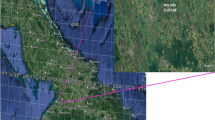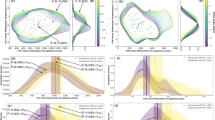Abstract
A fundamental challenge in climate science is decomposing the concurrent drivers of weather extremes in observations. Achieving this can provide insights into the drivers of individual extreme events as well as into possible future changes in extreme event frequencies under greenhouse forcing. In the present work, we exploit recent results from dynamical systems theory to study the co-variation and recurrence statistics of different atmospheric variables. Specifically, we present a methodology to quantify the recurrences of bivariate variables and the coupling between distinct univariate variables in terms of their joint recurrences. The coupling is defined by a parameter which varies according to the chosen variables, season, and domain and can be understood in terms of the underlying physics of the atmosphere. For suitably chosen variables, this approach enables to decompose the different drivers of weather extremes. Here, we compute the above metrics for near-surface temperature and sea level pressure, and use them to study warm or cold days over North America. We first identify states where temperature is strongly or weakly coupled to the large-scale atmospheric circulation, and then elucidate the interplay between coupling and the occurrence of temperature extremes.














Similar content being viewed by others
References
Abadi M, Freitas ACM, Freitas JM (2018) Dynamical counterexamples regarding the extremal index and the mean of the limiting cluster size distribution. arXiv preprint arXiv:180802970
Barros V, Liao L, Rousseau J (2019) On the shortest distance between orbits and the longest common substring problem. Adv Math 344:311–339
Bevacqua E, Maraun D, Hobæk Haff I, Widmann M, Vrac M (2017) Multivariate statistical modelling of compound events via pair-copula constructions: analysis of floods in Ravenna (Italy). Hydrol Earth Syst Sci 21(6):2701–2723
Brunetti M, Kasparian J, Vérard C (2019) Co-existing climate attractors in a coupled aquaplanet. Clim Dyn 53(9–10):6293–6308
Buschow S, Friederichs P (2018) Local dimension and recurrent circulation patterns in long-term climate simulations. Chaos Interdiscip J Nonlinear Sci 28(8):083,124
Cattiaux J, Vautard R, Cassou C, Yiou P, Masson-Delmotte V, Codron F (2010) Winter 2010 in Europe: a cold extreme in a warming climate. Geophys Res Lett 37(20):L20704
Cellitti MP, Walsh JE, Rauber RM, Portis DH (2006) Extreme cold air outbreaks over the United States, the polar vortex, and the large-scale circulation. J Geophys Res Atmos 111(D2):877–946
Comas-Bru L, McDermott F (2014) Impacts of the EA and SCA patterns on the European twentieth century nao-winter climate relationship. Q J R Meteorol Soc 140(679):354–363
Coumou D, Petoukhov V, Rahmstorf S, Petri S, Schellnhuber HJ (2014) Quasi-resonant circulation regimes and hemispheric synchronization of extreme weather in boreal summer. Proc Natl Acad Sci 111(34):12,331–12,336
Davies HC (2015) Weather chains during the 2013/2014 winter and their significance for seasonal prediction. Nat Geosci 8(11):833
Eckmann JP, Ruelle D (1992) Fundamental limitations for estimating dimensions and Lyapunov exponents in dynamical systems. Phys D Nonlinear Phenom 56(2–3):185–187
Faranda D, Freitas JM, Lucarini V, Turchetti G, Vaienti S (2013) Extreme value statistics for dynamical systems with noise. Nonlinearity 26(9):2597
Faranda D, Masato G, Moloney N, Sato Y, Daviaud F, Dubrulle B, Yiou P (2016) The switching between zonal and blocked mid-latitude atmospheric circulation: a dynamical system perspective. Clim Dyn 47(5–6):1587–1599
Faranda D, Messori G, Alvarez-Castro MC, Yiou P (2017a) Dynamical properties and extremes of northern hemisphere climate fields over the past 60 years. Nonlinear Process Geophys 24(4):713
Faranda D, Messori G, Yiou P (2017b) Dynamical proxies of North Atlantic predictability and extremes. Sci Rep 7(41):278
Faranda D, Sato Y, Saint-Michel B, Wiertel C, Padilla V, Dubrulle B, Daviaud F (2017c) Stochastic chaos in a turbulent swirling flow. Phys Rev Lett 119(1):014,502
Faranda D, Alvarez-Castro MC, Messori G, Rodrigues D, Yiou P (2019a) The hammam effect or how a warm ocean enhances large scale atmospheric predictability. Nat Commun 10(1):1316
Faranda D, Messori G, Vannitsem S (2019b) Attractor dimension of time-averaged climate observables: insights from a low-order ocean-atmosphere model. Tellus A Dyn Meteorol Oceanogr 71(1):1–11
Faranda D, Sato Y, Messori G, Moloney NR, Yiou P (2019c) Minimal dynamical systems model of the northern hemisphere jet stream via embedding of climate data. Earth Syst Dyn 10(3):555–567
Freitas ACM, Freitas JM, Todd M (2010) Hitting time statistics and extreme value theory. Probab Theor Relat 147(3–4):675–710
Galambos J, Lechner J, Simiu E, Hagwood C (1994) Extreme value theory for applications. NIST Technical Publications
Gálfi VM, Bódai T, Lucarini V (2017) Convergence of extreme value statistics in a two-layer quasi-geostrophic atmospheric model. Complexity 2017:1–20
Gnedenko B (1943) Sur la distribution limite du terme maximum d’une serie aleatoire. Ann Math 44:423–453
Grassberger P (1983) Generalized dimensions of strange attractors. Phys Lett A 97(6):227–230
Grassberger P, Procaccia I (1984) Dimensions and entropies of strange attractors from a fluctuating dynamics approach. Phys D Nonlinear Phenom 13(1–2):34–54
Grotjahn R (2016) Western North American extreme heat, associated large scale synoptic-dynamics, and performance by a climate model. Dyn Predict Large-Scale High-Impact Weather Clim Events 2:198
Harnik N, Messori G, Caballero R, Feldstein SB (2016) The circumglobal North American wave pattern and its relation to cold events in eastern North America. Geophys Res Lett 43(20):503
Hirschi M, Seneviratne SI, Alexandrov V, Boberg F, Boroneant C, Christensen OB, Formayer H, Orlowsky B, Stepanek P (2011) Observational evidence for soil-moisture impact on hot extremes in Southeastern Europe. Nat Geosci 4(1):17
Hochman A, Alpert P, Harpaz T, Saaroni H, Messori G (2019) A new dynamical systems perspective on atmospheric predictability: Eastern Mediterranean weather regimes as a case study. Sci Adv 5(6):eaau0936
Huke J (2006) Embedding nonlinear dynamical systems: a guide to Takens’ theorem. The University of Manchester, Manchester http://eprints.maths.manchester.ac.uk/175/1/embed.pdf (ISSN 1749-9097)
Kalnay E, Kanamitsu M, Kistler R, Collins W, Deaven D, Gandin L, Iredell M, Saha S, White G, Woollen J et al (1996) The NCEP/NCAR 40-year reanalysis project. Bull Am Meteorol Soc 77(3):437–471
Kornhuber K, Osprey S, Coumou D, Petri S, Petoukhov V, Rahmstorf S, Gray L (2019) Extreme weather events in early summer 2018 connected by a recurrent hemispheric wave-7 pattern. Environ Res Lett 14(5):054,002
Lee YY, Grotjahn R (2016) California central valley summer heat waves form two ways. J Clim 29(3):1201–1217
Lopez H, Lee SK, Dong S, Goni G, Kirtman B, Atlas R, Kumar A (2019) East Asian monsoon as a modulator of us great plains heat waves. J Geophys Res Atmos
Lucarini V, Faranda D, Wouters J (2012) Universal behaviour of extreme value statistics for selected observables of dynamical systems. J Stat Phys 147(1):63–73
Marwan N, Romano MC, Thiel M, Kurths J (2007) Recurrence plots for the analysis of complex systems. Phys Rep 438(5–6):237–329
Messori G, Caballero R, Gaetani M (2016) On cold spells in North America and storminess in Western Europe. Geophys Res Lett 43(12):6620–6628
Messori G, Caballero R, Faranda D (2017) A dynamical systems approach to studying midlatitude weather extremes. Geophys Res Lett 44(7):3346–3354
Messori G, Woods C, Caballero R (2018) On the drivers of wintertime temperature extremes in the high Arctic. J Clim 31(4):1597–1618
Messori G, Davini P, Alvarez-Castro MC, Pausata FS, Yiou P, Caballero R (2019) On the low-frequency variability of wintertime Euro-Atlantic planetary wave-breaking. Clim Dyn 52(3–4):2431–2450
Moloney NR, Faranda D, Sato Y (2019) An overview of the extremal index. Chaos Interdiscip J Nonlinear Sci 29(2):022,101
Murray RJ, Simmonds I (1991) A numerical scheme for tracking cyclone centres from digital data. Aust Meteorol Mag 39(3):155–166
Palmer T (2013) Climate extremes and the role of dynamics. Proc Natl Acad Sci 110(14):5281–5282
Pickands J III (1975) Statistical inference using extreme order statistics. Ann Stat 3:119–131
Rodrigues D, Alvarez-Castro MC, Messori G, Yiou P, Robin Y, Faranda D (2018) Dynamical properties of the North Atlantic atmospheric circulation in the past 150 years in cmip5 models and the 20crv2c reanalysis. J Clim 31:6097–6111
Rousseau J (2014) Hitting time statistics for observations of dynamical systems. Nonlinearity 27(9):2377
Rousseau J, Saussol B (2010) Poincaré recurrence for observations. Trans Am Math Soc 362(11):5845–5859
Scher S, Messori G (2018) Predicting weather forecast uncertainty with machine learning. Q J R Meteorol Soc 144(717):2830–2841
Scher S, Messori G (2019) Weather and climate forecasting with neural networks: using general circulation models (GCMs) with different complexity as a study ground. Geosci Model Dev 12(7):2797–2809
Sung MK, Jang HY, Kim BM, Yeh SW, Choi YS, Yoo C (2019) Tropical influence on the North Pacific oscillation drives winter extremes in North America. Nat Clim Change 9(5):413
Süveges M (2007) Likelihood estimation of the extremal index. Extremes 10(1–2):41–55
Von Storch H, Zwiers FW (2001) Statistical analysis in climate research. Cambridge University Press, Cambridge
Walsh JE, Phillips AS, Portis DH, Chapman WL (2001) Extreme cold outbreaks in the United States and Europe, 1948–99. J Clim 14(12):2642–2658
Yiou P, Salameh T, Drobinski P, Menut L, Vautard R, Vrac M (2013) Ensemble reconstruction of the atmospheric column from surface pressure using analogues. Clim Dyn 41(5–6):1333–1344
Zscheischler J, Seneviratne SI (2017) Dependence of drivers affects risks associated with compound events. Sci Adv 3(6):e1700,263
Acknowledgements
DF, PY and GM acknowledge the support of the ERC Grant no. 338965-A2C2. GM was partly supported by the Swedish Research Council Vetenskapsrådet no. 2016-03724. DF and PY were further supported by a CNRS-INSU LEFE/MANU grant (DINCLIC project).
Author information
Authors and Affiliations
Corresponding author
Additional information
Publisher's Note
Springer Nature remains neutral with regard to jurisdictional claims in published maps and institutional affiliations.
Rights and permissions
About this article
Cite this article
Faranda, D., Messori, G. & Yiou, P. Diagnosing concurrent drivers of weather extremes: application to warm and cold days in North America. Clim Dyn 54, 2187–2201 (2020). https://doi.org/10.1007/s00382-019-05106-3
Received:
Accepted:
Published:
Issue Date:
DOI: https://doi.org/10.1007/s00382-019-05106-3




